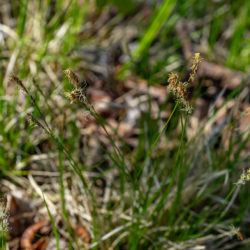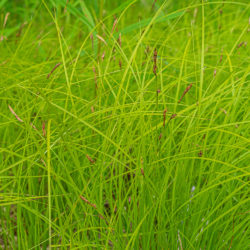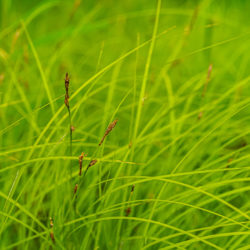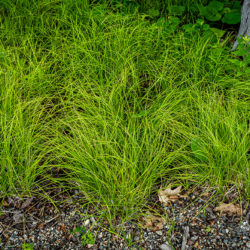Etymology
Carex is Latin for cutter, in reference to sharp leaves and stem edges; pensylvanica is Latin for “of Pennsylvania.”
Native Habitat
Thickets and dry woodland areas in Eastern and Central North America.
Garden Uses
Pennsylvania sedge is a useful groundcover for dry shade, as an underplanting for shade perennials or as a lawn substitute for dry soils in shady areas. It forms a turf that never needs mowing or can be mowed 2-3 times per year to 2" tall. May be best to use purchased plants for covering large areas because this species often does not grow well from seed. No serious insect or disease problems.
Overview
Pennsylvania sedge (or Penn sedge) is a shade-loving perennial sedge that is native to thickets and dry woodland areas in Eastern and Central North America. It grows in loose colonies with a creeping habit. It typically grows in a clump to 8 inches tall. It is semi-evergreen in moderately cold winter climates. It prefers loose loam in dry soils and sun-dappled part shade. Most sedges prefer moist to wet soils, but not this one. The plants spread by underground rhizomes and less frequently, it may self-seed. It is often found in areas with oak trees, hence the additional common name of oak sedge.
Leaves and Stems
This is a low sedge with soft, delicate, arching, semi-evergreen leaves (each to 1/8" wide). Narrow, grass-like, medium green leaves (to 8-12" long) are typically shorter than the flowering stems.
Flowers
Plants are monoecious (spikelets of male flowers above female flowers). Flowers bloom in late spring (June) in inflorescences atop rough, sharply triangular culms (stems) which rise up singly from the rhizomes. Staminate (male) scales are green, often tinged with reddish-purple with white margins. Pistillate (female) scales are dark brown to purplish black with green midribs and white margins.
Fruit/Seed
Female flowers are followed by tiny fruits (achenes) enclosed in sac-like bracts (perigynia).
Wildlife Associates
Given the understated flowers on Carex species, one wouldn’t expect them to be on a list of butterfly plants, however, this is a great pollinator plant, supporting dozens of butterfly and moth species and is host plant to 36 species of caterpillar. In the wild, it provides shelter, nesting material, and is also a good seed source for birds. Ducks use this sedge for nesting material and some cover. Pennsylvania sedge provides support for the birds and mammals that keep insect populations in balance.
Propagation
Divide mature plants in spring, making sure each section has roots and leaves.
Ethnobotanical Uses
Carex have been valued primarily as fiber plants and as forage for livestock.
Garden Location
Performance Hall Garden (see garden map)
Sources
Plant Profile by Kathy Kling




